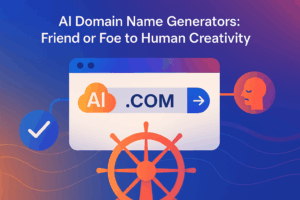On the Record: Tune.com

In 2009, a company called HasOffers created a piece of affiliate network software that soon attracted a core of dedicated users. However, the rapid growth of the company meant that they were looking to offer a wider range of products under a new brand name. Ultimately, that brand name was Tune, using the Tune.com domain name.
This edition of On the Record shines a spotlight on the gradual transition that Has Offers undertook to become Tune.com. We talk with Brian Marcus, Tune’s VP of Global Marketing, to dig deeper into why the company rebranded from HasOffers to Tune, how core customers were affected by the move, and how the company managed to acquire the ultra-premium Tune.com domain name.
Can you give us the background of Tune, and what you do?
I need to discuss the domain I own!
The first TUNE product was launched in 2009. We called it Has Offers because it was a white label solution that allowed anyone to manage their own offers for affiliates and partners to promote. In the following years, hundreds of new and existing companies built their business on our platform, making HasOffers the most adopted SaaS solution for affiliate and ad networks.
Today, TUNE delivers the industry’s most flexible SaaS solution for managing marketing partnerships across mobile and web. On a single platform, TUNE customers can maximize ROI from onboarding through payout with their most important partners – affiliates, networks, influencers, agencies, and any other business development relationships. Our company keeps this as our singular focus for innovation, now and as we look toward the future of performance marketing partnerships.
How long into your company’s operation was it before you seriously considered rebranding, and why did you ultimately choose to do so?
About six years, or 2015. That’s when we purchased the tune.com domain name, with the intent of using “TUNE” as our parent company name. We had always had aspirations of moving beyond just offers, and as such, we were quickly outgrowing the name HasOffers. Once we had multiple products, we felt that we needed a broader, mission-oriented brand, as we could no longer fit this growing company under the very specific product name it had come from. It was time to start building a longer-term identity.
As we began evolving our core product to support advertisers, we ran into the same challenge. The name “HasOffers” resonated with our longtime customer base – ad networks, affiliate networks, and agencies – yet we wanted to make it clear to advertisers that we now fully and directly serve them as well.
How did you come up with the “Tune” brand name? Was it a case of finding the domain name first? (i.e. making sure Tune.com was available, before committing to the brand name?)
We knew that we wanted a .com domain, hopefully, one to two words, so we started looking for what was available and possible. Ryan Colby actually surfaced the tune.com domain for us early on in our search, but it seemed potentially out of reach, and perhaps even too bold. As time passed and our search continued, the name resonated more than any other option with our approach to software, products, customer service, and focus on optimization. On top of that, it’s a fun name, and we felt it reflected a core part of our culture, which was important to us. Eventually, we decided to go for it.
What factors did you consider to be important when coming up with a new brand name?
The most important thing about a brand name is recall. How easy is it to remember? A name like TUNE stands out, especially in the B2B space, and the simplicity speaks to our professionalism and how easy we are to do business with. At one point, we even had an agency work on our brand name project. To us, it seemed that the names the agency offered were disconnected from our culture and difficult for us to remember. (Some of the names offered felt more fitting to a pharmaceutical company.) After that experience, we gave serious reconsideration to tune.com. It was easy to remember, clean, simple, versatile, and as an added bonus, it gave us a verb and a feeling of connection that is so important to marketing relationships. With TUNE, we got it all.
How did you make the transition from HasOffers to Tune.com easier for your longtime customer base?
TUNE launched its brand transition through a series of integrated marketing communications, across its paid, owned and earned marketing channels. Ensuring a well-orchestrated communication plan (across our website, social pages, sales collateral, customer newsletters, events, etc.) provided air-cover for our client-facing teams to reposition and ensure no client felt left behind. Also, making sure our long-term clients were ahead of the curve on all communications (via our Customer Success Teams) mitigated any potential for surprises.
Central to our communications was creating transparency around “the why” behind the change and its connection to the new brand name. We were also clear about “the how” we were making this change, revealing a new roadmap that would make all of our customers successful. It was super important that long-time customers saw themselves firmly in the future roadmap.
You also own the @Tune handle on Instagram, Twitter, and Facebook. How important, to you, is a memorable social media username versus a premium domain name?
Consistency is most important when tracking across social channels. If you can’t get your most important channels secured, you may want to consider an overall change. That said, it depends on your timelines and goals as a business.
Can you reveal how much you paid to acquire the Tune.com domain?
Unfortunately, we can’t disclose the price, but we made a demonstrable improvement on the asking price.
How did you evaluate an acceptable price or budget for a domain? Was it budget-driven by internal data such as your own sales revenue, or was it influenced by domain name data such as appraisals or expert opinion?
We worked with Ryan Colby throughout the process, but we also considered the value we could drive through better name recognition and curb appeal to enterprise businesses. Like with any investment, you at least need to build a hypothetical proforma.
In 2019, after a decade of using the name, you’ve completely retired the HasOffers brand name and replaced the HasOffers service with the Tune branding. What was your reasoning for phasing out HasOffers completely?
HasOffers has transformed over the last 18 months to support a larger audience of marketers, and we needed to make it clear to the market that a major change had occurred. We dramatically increased our investment in product and engineering, making some unparalleled improvements to our ecosystem, which in turn, supported the case for a new name. The name TUNE better fit the hundreds of improvements we made and helped us easily expand to entirely new feature sets, like our new payment product, TUNE Pay. We wanted to represent our evolution and progress to our customers, our future customers, and importantly, to our own employees.
What advice would you give to any company looking to rebrand to a premium domain name? Are there any obvious advantages or pitfalls that need to be taken into consideration?
It is important to recognize the right timing. Brand names only become critical after you have achieved a certain scale, but they also require time to take hold once you’re in the market. Changing your name can have a huge impact on your short-term company recall, and it will take diligent work and a couple of years to get people saying, repeating, and promoting the new name. That said, if you start to deal with multiple product lines or new audiences, it may be time to find a name that applies to every product and team in your company. If I’ve learned anything, it is that the right name can really unify your organization.
You mentioned that a name change can have an impact on short-term company recall. How did switching from HasOffers to Tune.com affect your overall business in the 12 months after you switched?
Given that our brand was already well known within the mobile advertiser segment (i.e. from our attribution software), leaning into the TUNE brand name for the Partner Marketing Platform was a natural transition for many Advertisers. Our simplified messaging and product SKU structure enabled us to quickly create a strong pipeline of leads and trial signups, once relaunched.
—
Thanks to Brian for discussing Tune’s transition from HasOffers to Tune.com. If you’re interested in following Tune’s journey, you can visit @Tune on Facebook, Twitter, or Instagram.
This interview has been edited for clarity.



